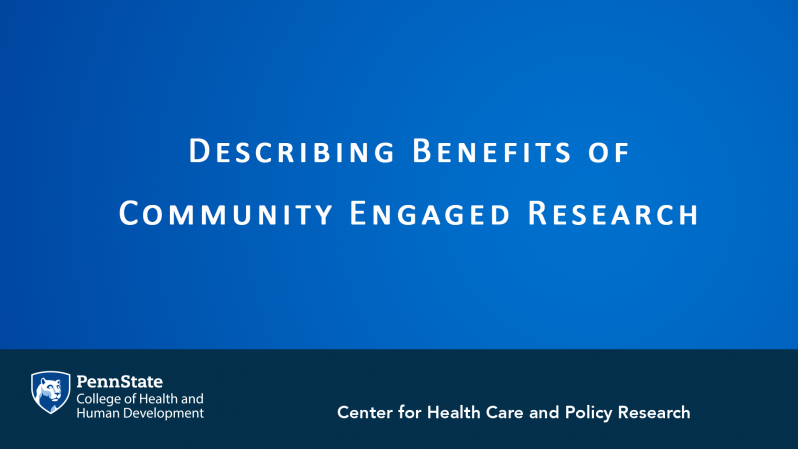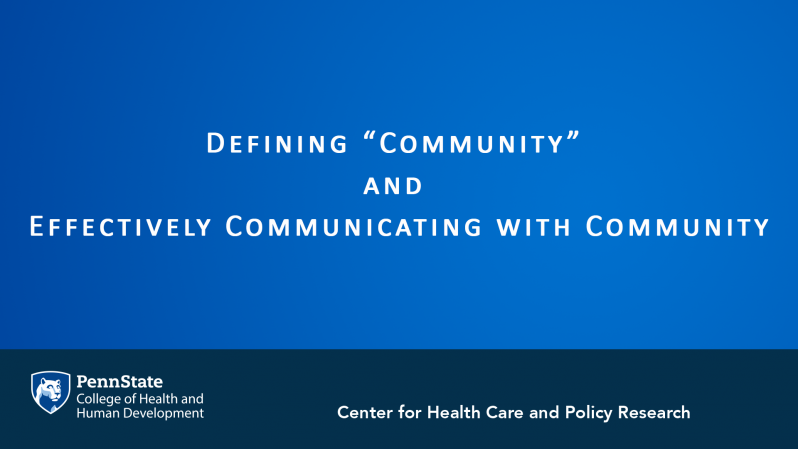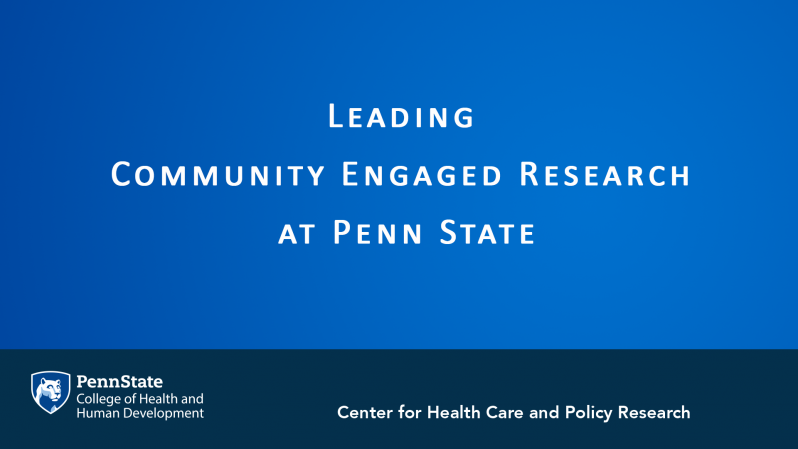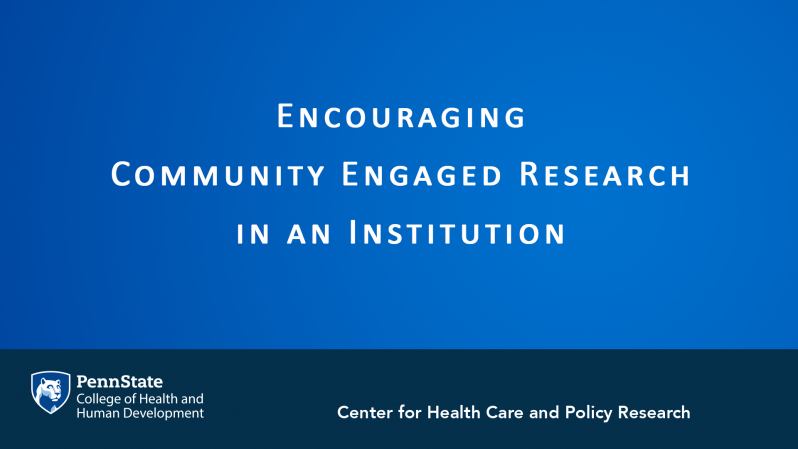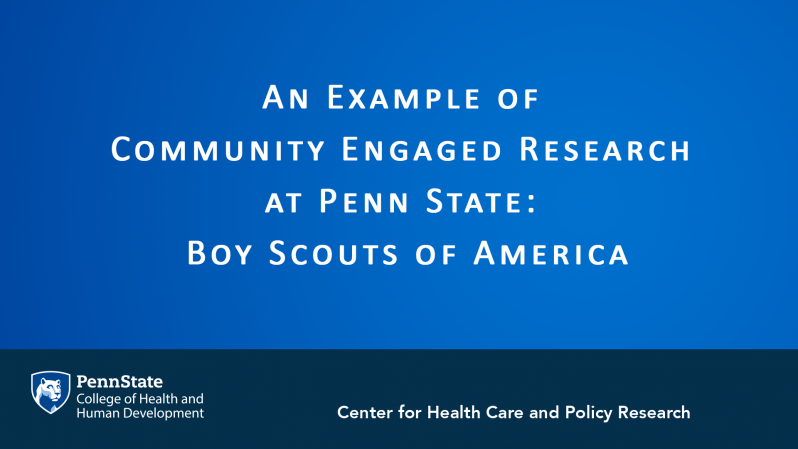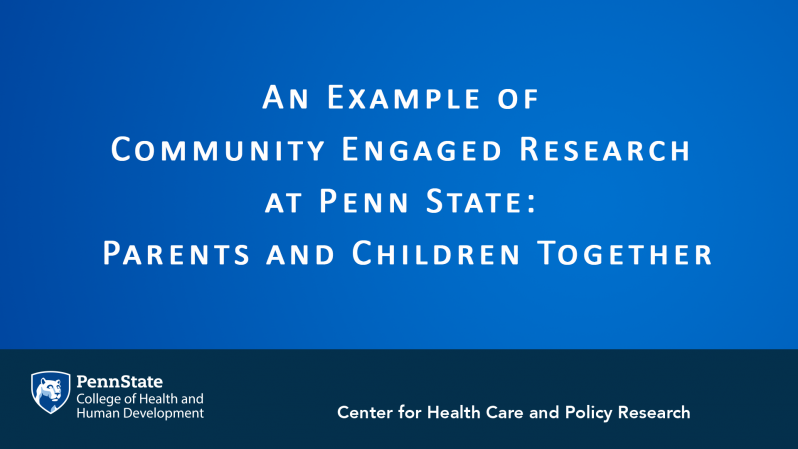Community-Engaged Research
Ask the Experts
Jen Kraschnewski, MD, MPH, Penn State College of Medicine
In this discussion of our “Ask the Experts” series, Dr. Dennis Scanlon speaks with Jen Kraschnewski, MD, MPH, with the Penn State College of Medicine in her role as co-chair of the Penn State Clinical and Translational Science Institute’s Community-Engaged Research Core. They discuss community-engaged research, why it is important, where it is happening at Penn State, and how to learn more about it.
Interview Highlights
Defining “Community Engaged Research” and Understanding Its Use
“Community engaged research is really a very wide spectrum of different types of research, and this can involve anything from a very light touch with engaging community to a very more hands-on approach. One end of the spectrum would be community-based participatory research…[where] researchers partner with a community…and really allow that community to drive the research agenda. On the other end of the spectrum, we have research projects that come to the community to engage them in different aspects of that project.”
“Unfortunately [community engaged research] is not something that happens as much as we think it should happen …Part of this reason has to do with funding, so traditional NIH (National Institutes of Health) funding…only pennies on the dollar are spent in this type of work compared to other types of research, but the community’s really not at the table. We think it’s critically important to bring the community to the table because the problems that we’re trying to address in our research occur in the community setting, and to not engage that setting and that population in the research really ignores the barriers and challenges that occur and can make the research less effective.”
Describing Benefits of Community Engaged Research
“Unfortunately, there’s still that stigma that research involves being a guinea pig… Community engaged research can help break down some of the barriers and increase understanding of actually the wide spectrum of research within what we as researchers do every day. Beyond that, it gives the community partners an opportunity to have their voice heard…and integrated into what’s being done… and as a result, we’re more likely to find effective solutions to problems that exist, and ultimately that will help everyone.”
Defining “Community” and Effectively Communicating with Community
“Community actually can mean many different groups of individuals… in my mind, community is a population that could benefit from the work that a researcher is doing…There are, absolutely, barriers to community engaged research, and that’s one thing, through the CTSI, Community Engaged Research Core, that we’ve been working hard to try to develop in terms of resources that could help investigators with this… Some of the very straightforward first steps are establishing that relationship and by education for the community partner or community group that the researcher is working with to make sure that everyone’s on the same page… We have to be able to speak the same language in order to communicate effectively, so really making sure that researchers use language that’s very community facing and for the community, helping them to understand the basics of the research design, so that they feel empowered to be able to give their thoughts in a free fashion.”
Leading Community Engaged Research at Penn State
“One of the goals of the Clinical and Translational Sciences Institute, or the CTSI, here at Penn State is to translate science. There’s great understanding that we can do excellent work, but if it’s never disseminated, the results aren’t really helpful to anyone. One of those focuses has created the Community Engaged Research Core” and one of the first steps the Community Engaged Research Core has taken is to complete an inventory of “greater than 90 different investigators across our university …who identify themselves as community engaged researchers. This is going to be a tremendous resource moving forward for us to really understand: What does community engaged research look like on our campus? Beyond that, we’ve developed a series of toolkits for both researchers, as well as community engaged projects, which include things like: How do I have my community partner be a part of my study without having to go through the same kind of intensive human subjects protection training that investigators need to go through in order to have approval through our institutional review board?”
Encouraging Community Engaged Research in an Institution
“This is definitely a growing field, and I would say, maybe ten years ago, it looked a little bit different for researchers interested in this area, but it traditionally hasn’t been emphasized as greatly. With more and more emphasis on team science, community engaged research has really risen in terms of recognition for researchers who complete this type of work. I think, more importantly than institutional recognition, it offers really great benefit outside of other studies…By engaging community members in different aspects, I’ve personally found it to be incredibly rewarding, and some of my favorite days are spent with our community partners.”
An Example of Community Engaged Research at Penn State: Partnership with Boy Scouts of America
“At the Penn State PRO Wellness Center, we actually spend a lot of our time engaged with community in different types of projects, and one in particular that I would like to highlight has been our partnership with the Boy Scouts of America. This began about two years ago now. It started out as a request from the national Boy Scouts office for assistance with addressing the obesity epidemic among boy scouts, as well as across our country. Through early partnership with that organization, we tried to understand what their goals were for this project and what a partnership could look like….We came up with really clever, innovative ways of taking what’s known in other practices and translating that to the Boy Scout camp to make them healthier, both in terms of the food that they were serving, the foods that they were selling at their trading post, and in increasing physical activity among the scouts while in their weeks at the camp. This partnership expanded from our local Pennsylvania council to this past summer where we have now partnered with Atlanta, Georgia and Phoenix, Arizona camps to reach over 15,000 scouts, with plans to go beyond for next summer, as well.”
“One of my highlights of this Boy Scouts work is the fact that our initial scout executive…has really been a true partner in this work and has co-presented with us at multiple meetings… Having a true community partner who can speak to your work resonates really well for how community engaged research can change what you’re planning to do.”
“One of the things the partnership demonstrated to us was that we really had to be cautious about going in and making all the changes at once. These were rolled out in a stepwise fashion so that we had time to engage the different camp staff who would be involved in the implementation of the changes and get their buy-in, and, of course, having our council executive’s buy-in was really critical to the success of the project.”
“We have lots of ideas and plans for future work with the Boy Scouts. We agree this is a very short period of time, but we’d also like to think that this could be an “aha” moment…Our hope is that this could help spark interest. It can help set a culture that the scouts is a place for health, in addition to all of the other great activities that they engage in, and moving forward, we can translate some of these thoughts into the other scout activities and beyond.”
An Example of Community Engaged Research at Penn State: Parents and Children Together (PACT)
“PACT stands for Parents and Children Together, and this was a group that was started about 13 years ago by researchers at University Park who really wanted to have a community engaged relationship for research within the Harrisburg community. This organization brings together multiple different community partners who represent community voices throughout Harrisburg, and it really works in the sense of allowing a forum for researchers to present potential research ideas to community partners who then have a voice in whether or not that type of work would resonate with their community. It allows the community to bring to the table what their most pressing issues are and where they think they can partner with researchers, so it’s a really great example of a connection that researchers can make with a community that’s already established, which overcomes many of the barriers to getting started in this type of work.”
Parting Wisdom on Community Engaged Research
“I really think it’s through furthering community engaged research that we’re going to be able to overcome many of the barriers that we see today with research actually being successfully disseminated into community settings. I would be delighted to have anyone who’s watching this contact me for more information. One of my hopes is that, in the next iteration, the Community Engaged Research Core can actually field questions and requests for partnership from community members to help make a bidirectional relationship with the university for this type of work.”


